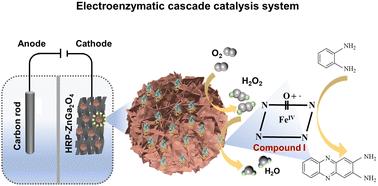HRP-ZnGa2O4纳米生物杂化物上的电酶级联合成2,3-二氨基非那嗪
IF 9.2
1区 化学
Q1 CHEMISTRY, MULTIDISCIPLINARY
引用次数: 0
摘要
在这项工作中,开发了一种新的纳米生物杂化物,用于通过电酶级联催化系统高效合成2,3-二氨基吩嗪(DAP),这是一种具有重要生物学意义的杂环化合物。将辣根过氧化物酶(HRP)与高表面积没食子酸锌(ZnGa2O4)纳米花相结合。ZnGa2O4组分具有两种功能,一种是HRP的有效固定载体,另一种是双电子氧还原反应(2e−ORR)原位生成过氧化氢(H2O2)的电催化剂。这种原位生成的H2O2直接激活固定的HRP,在集成的纳米生物杂交体中启动邻苯二胺(OPD)的酶促氧化成DAP。利用纳米级的接近性,这种结构促进H2O2有效地通道到HRP活性中心,并通过应用电位调节精确控制H2O2的产量,从而满足酶催化的要求。因此,与依赖外源H2O2的传统系统相比,该电酶级联催化系统的DAP生产效率提高了4.48倍,在20分钟内达到89.44%的OPD转化率。这项工作证明了电催化和酶催化在集成纳米生物杂交体中耦合的潜力,以开发高效和可控的合成过程。本文章由计算机程序翻译,如有差异,请以英文原文为准。

Electroenzymatic cascade synthesis of 2,3-diaminophenazine on HRP-ZnGa2O4 nano-biohybrids
In this work, a novel nano-biohybrid has been developed for the efficient synthesis of 2,3-diaminophenazine (DAP), a biologically significant heterocyclic compound, via an electroenzymatic cascade catalysis system. Horseradish peroxidase (HRP) was integrated with high-surface-area zinc gallate (ZnGa2O4) nanoflowers. The ZnGa2O4 component serves dual functions as an effective immobilization support for HRP and as an electrocatalyst for the two-electron oxygen reduction reaction (2e−ORR) to generate hydrogen peroxide (H2O2) in situ. This in situ generated H2O2 directly activates the immobilized HRP, initiating the enzymatic oxidation of o-phenylenediamine (OPD) to DAP within the integrated nano-biohybrids. Capitalizing on nanoscale proximity, this architecture facilitates efficient channeling of H2O2 to the HRP active center and enables precise control over H2O2 yield through applied potential tuning, thereby matching enzymatic catalysis requirements. Consequently, this electroenzymatic cascade catalysis system achieves a 4.48-fold higher efficiency for DAP production compared to a conventional system relying on exogenous H2O2 addition, reaching 89.44% conversion of OPD in just 20 minutes. This work demonstrates the potential of coupling electrocatalysis and enzyme catalysis within integrated nano-biohybrids for developing highly efficient and controllable synthetic processes.
求助全文
通过发布文献求助,成功后即可免费获取论文全文。
去求助
来源期刊

Green Chemistry
化学-化学综合
CiteScore
16.10
自引率
7.10%
发文量
677
审稿时长
1.4 months
期刊介绍:
Green Chemistry is a journal that provides a unique forum for the publication of innovative research on the development of alternative green and sustainable technologies. The scope of Green Chemistry is based on the definition proposed by Anastas and Warner (Green Chemistry: Theory and Practice, P T Anastas and J C Warner, Oxford University Press, Oxford, 1998), which defines green chemistry as the utilisation of a set of principles that reduces or eliminates the use or generation of hazardous substances in the design, manufacture and application of chemical products. Green Chemistry aims to reduce the environmental impact of the chemical enterprise by developing a technology base that is inherently non-toxic to living things and the environment. The journal welcomes submissions on all aspects of research relating to this endeavor and publishes original and significant cutting-edge research that is likely to be of wide general appeal. For a work to be published, it must present a significant advance in green chemistry, including a comparison with existing methods and a demonstration of advantages over those methods.
 求助内容:
求助内容: 应助结果提醒方式:
应助结果提醒方式:


